Book contents
- Frontmatter
- Contents
- Acknowledgments
- Acronyms
- Political Map of China
- Political Map of India
- Introduction: China and India in the Age of Globalization
- 1 Prelude to Globalization: China (1949–1978) and India (1947–1991)
- 2 China and India Embrace Globalization
- 3 China: Strategies and Patterns of Global Integration
- 4 India: Strategies and Patterns of Global Integration
- 5 Sino-Indian Relations: Partners, Friends, or Rivals?
- 6 India and the United States: From Estrangement to Engagement
- 7 The Rise of China and Its Implications for the United States
- 8 China and India: Future Challenges and Opportunities
- Bibliography
- Index
- References
Bibliography
Published online by Cambridge University Press: 22 January 2010
- Frontmatter
- Contents
- Acknowledgments
- Acronyms
- Political Map of China
- Political Map of India
- Introduction: China and India in the Age of Globalization
- 1 Prelude to Globalization: China (1949–1978) and India (1947–1991)
- 2 China and India Embrace Globalization
- 3 China: Strategies and Patterns of Global Integration
- 4 India: Strategies and Patterns of Global Integration
- 5 Sino-Indian Relations: Partners, Friends, or Rivals?
- 6 India and the United States: From Estrangement to Engagement
- 7 The Rise of China and Its Implications for the United States
- 8 China and India: Future Challenges and Opportunities
- Bibliography
- Index
- References
- Type
- Chapter
- Information
- China and India in the Age of Globalization , pp. 277 - 310Publisher: Cambridge University PressPrint publication year: 2009



